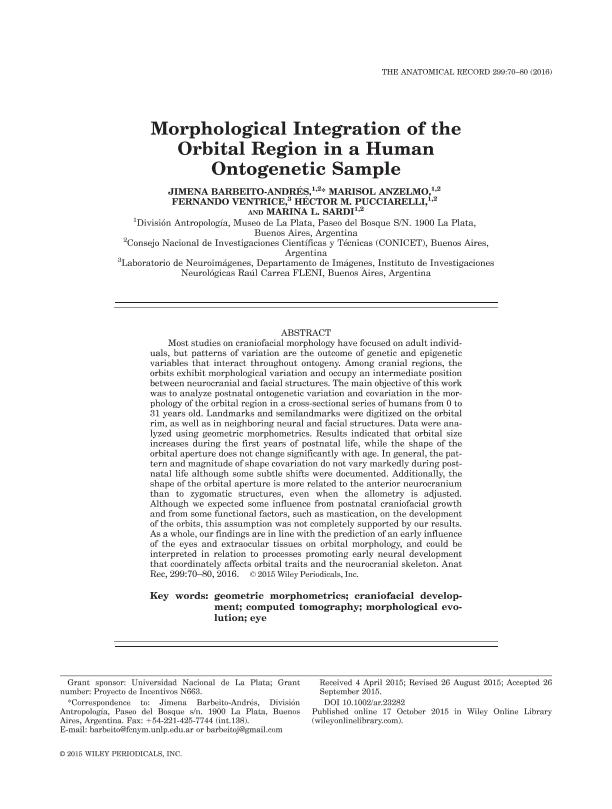Artículo
Morphological Integration of the Orbital Region in a Human Ontogenetic Sample
Barbeito Andrés, Jimena ; Anzelmo, Marisol
; Anzelmo, Marisol ; Ventrice, Fernando; Pucciarelli, Hector Mario
; Ventrice, Fernando; Pucciarelli, Hector Mario ; Sardi, Marina Laura
; Sardi, Marina Laura
 ; Anzelmo, Marisol
; Anzelmo, Marisol ; Ventrice, Fernando; Pucciarelli, Hector Mario
; Ventrice, Fernando; Pucciarelli, Hector Mario ; Sardi, Marina Laura
; Sardi, Marina Laura
Fecha de publicación:
01/2016
Editorial:
Wiley-liss, Div John Wiley & Sons Inc
Revista:
Anatomical Record-Advances in Integrative Anatomy and Evolutionary Biology
ISSN:
1932-8486
Idioma:
Inglés
Tipo de recurso:
Artículo publicado
Clasificación temática:
Resumen
Most studies on craniofacial morphology have focused on adult individuals, but patterns of variation are the outcome of genetic and epigenetic variables that interact throughout ontogeny. Among cranial regions, the orbits exhibit morphological variation and occupy an intermediate position between neurocranial and facial structures. The main objective of this work was to analyze postnatal ontogenetic variation and covariation in the morphology of the orbital region in a cross‐sectional series of humans from 0 to 31 years old. Landmarks and semilandmarks were digitized on the orbital rim, as well as in neighboring neural and facial structures. Data were analyzed using geometric morphometrics. Results indicated that orbital size increases during the first years of postnatal life, while the shape of the orbital aperture does not change significantly with age. In general, the pattern and magnitude of shape covariation do not vary markedly during postnatal life although some subtle shifts were documented. Additionally, the shape of the orbital aperture is more related to the anterior neurocranium than to zygomatic structures, even when the allometry is adjusted. Although we expected some influence from postnatal craniofacial growth and from some functional factors, such as mastication, on the development of the orbits, this assumption was not completely supported by our results. As a whole, our findings are in line with the prediction of an early influence of the eyes and extraocular tissues on orbital morphology, and could be interpreted in relation to processes promoting early neural development that coordinately affects orbital traits and the neurocranial skeleton.
Palabras clave:
Geometric Morphometrics
,
Craniofacial Development
,
Computed Tomography
,
Eye
Archivos asociados
Licencia
Identificadores
Colecciones
Articulos(IGEVET)
Articulos de INST.DE GENETICA VET ING FERNANDO NOEL DULOUT
Articulos de INST.DE GENETICA VET ING FERNANDO NOEL DULOUT
Citación
Barbeito Andrés, Jimena; Anzelmo, Marisol; Ventrice, Fernando; Pucciarelli, Hector Mario; Sardi, Marina Laura; Morphological Integration of the Orbital Region in a Human Ontogenetic Sample; Wiley-liss, Div John Wiley & Sons Inc; Anatomical Record-Advances in Integrative Anatomy and Evolutionary Biology; 299; 1; 1-2016; 70-80
Compartir
Altmétricas



